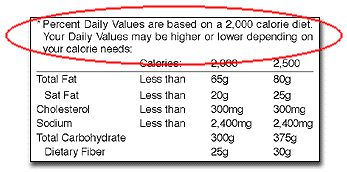
Picture this; you are at the grocery store and you are trying to decide between two different brands of granola for your morning yogurt and you are struggling with the question ‘which is healthier?’ Maybe you look at the name and think “Bear Naked Granola, that shit’s catchy,” which, kudos to marketing on that one. Even I was interested when that first hit stores. Once you detach yourself from the targeted marketing, you decide to look at the nutrition fact label, that ominous label on the side of the package, and try to make your comparisons there. This, my friends, is a much better way to compare. Food labels can be pretty confusing for people on their first pass but they don’t have to be, nor should they be. The Food labeling requirements were recently updated, so I think it’s a good time to talk food labeling. Here is what you need to know and understand about the food label.
Serving size & calories: From the top, first check out the serving size of the product. Is that a realistic amount for you to eat in a sitting? Scale it appropriately for how much you think you would eat. For example, a serving size of Oreos is 2… yup, just 2. Most people eat 4 or more. In that case, double all calories and nutrients.
Total fat, saturated fat, trans fat, oh my: Fat is an essential nutrient; we need it. We could have an argument here about saturated fat and how the recommended daily amount may be a bit too restrictive, but that’s for another article! Generally speaking, when looking at most foods with a food label (dairy products excluded) you should look for foods with low saturated fat (5-6% of calories) as well as low to no trans-fat. Trans fat is bad news, please avoid when at all possible.
Cholesterol from foods does not correlate to high blood cholesterol. If you have high cholesterol limit your saturated fats from processed foods and increase your fiber intake.
Low Sodium is considered under 140mg of sodium per serving. It is generally recommended to not consume more than 2300mg of sodium a day, although most Americans consume WAY more that that. Your normal diet and how much processed food you eat will dictate how much sodium is sensible for a single food item. If you eat a lot of processed/ canned foods look for low sodium options (under 140mg per serving). If you eat a diet higher in whole foods, which are naturally low in sodium, you can be more liberal about sodium intake from other foods.
Carbohydrates & the new added sugar: NEW FEATURE ALERT! There is now added sugar row under carbohydrates which is pretty exciting, if you ask me. This is most exciting for me because things like yogurt naturally have sugar in them. The problem is, most companies add a lot more sugar for flavor, so it was hard for consumers to tell which sugar was normal diary sugar and which was were refined additions. Now you’ll know. Food companies have gotten an extension until 2020 to comply so you should start seeing this change over time. Fiber is also under carbohydrates. Look for products that contain fiber to promote a healthy gut, especially when selecting grains.
Protein: This one if pretty straight forward. Remember, foods that are higher in protein will be more satiating (filling) then foods high in carbohydrates or fat.
Vitamins & Minerals: It is only required that food labels include amounts of calcium, potassium, vitamin D and iron. Other nutrients like vitamin C and A can be included on a voluntary basis. The more vitamins and minerals the merrier!
The Ingredient list: Foods with more than 1 ingredient have to have an ingredient list. Ingredients of the product are then listed in descending order by weight, largest contributing ingredients listed first. When looking at the ingredient list, a short list is best! As I have said it previous articles, I do not like the rule that if you can’t pronounce the ingredient don’t buy it. Thiamine, riboflavin, niacin, and pantothenic acid are not easily recognizable to most people BUT are all B vitamins (B1, B2, B3, B5 respectively) and contribute to overall health. Going for the shortest list (least processed) and avoiding artificially flavored foods are both solid rules to follow.

The % Daily Value as a guide: The daily value (DV) percent are based on a 2000 calorie diet. Most of the people I work with, myself included, are not on a 2000 calorie diet, so it would seem this column wouldn’t be of much help. Honestly, for some people, it is not really all that helpful at all. BUT it can be helpful when making a quick evaluation of the food. For example, if a food has 5% or less fat in the DV column, that is considered a low fat food. Above 20% is considered high in fat. This rule can be used with any of the nutrients if you are tracking macronutrients.
Moral of story: Labels might seem confusing but they will tell you everything you need to know in order to make an informed decision! Take advantage of that with this knowledge and you will have better control over your health. You are in control, my friends, and what you buy or do not buy at the grocery store is what moves the market forward. You choose healthier products and companies will strive to meet the demand of creating more wholesome products! Have questions? Ask!
Grow Strong my friends,
Haley Schlechter, RD, LDN

